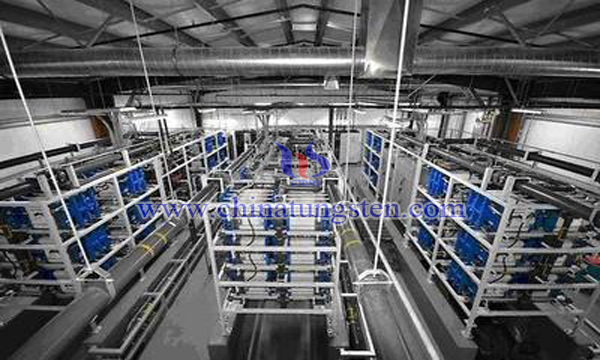Upgrading and Modification of Electrode For All-vanadium Liquid Flow Battery
- Details
- Category: Tungsten Information
- Published on Saturday, 02 February 2019 23:40
All-vanadium redox battery is a kind of redox battery which uses vanadium as active material and circulates in liquid state. Both positive and negative active substances are vanadium sulfuric acid solution. Electrode reaction occurs in liquid phase, which greatly reduces the electrochemical polarization. Its rated power and rated power can be designed separately. By changing the electrolyte, instantaneous charging can be achieved, and 100% deep discharge will not damage the battery. Based on the above advantages, it can be widely used in photovoltaic power generation, wind power generation, smart grid, peak valley power, distributed power stations, communication base stations, UPS/EPS, transportation and military fields.

At present, carbon graphite felt or carbon felt is the main electrode material used in all-vanadium flow battery. The material has the advantages of low resistivity, large specific surface area, chemical and electrochemical stability. However, the electrochemical activity of all-vanadium flow battery electrode reaction on its surface is low, so it is necessary to activate graphite felt or carbon felt to improve its electrochemical activity and battery performance. Some scholars have proposed that transition metal modification can be used to improve the electrochemical activity of carbon fibers, such as tungsten oxide catalyst. The modification process is as follows:
1)Preparation of spinning solution: polyacrylonitrile or polyethylene glycol was added to dimethylformamide or dimethylacetamide in a certain proportion, and stirred uniformly in water bath.
2)Tungstate is proportionally added to the spinning solution described in step 1, and is evenly dispersed by stirring or ultrasound. The stirring time of tungstate in composite spinning solution is 6-18 hours and the ultrasonic time is 2-6 hours.
Among them, inorganic or organic salts containing tungsten include ammonium tungstate, sodium tungstate, silicotungstic acid and phosphotungstic acid.
3)The composite spinning solution obtained in step 2 was used to prepare nanofibers film by electrospinning technology. The thickness of nanofibers film was 0.5-5 mm.
4)Pre-oxidation and carbonization of the obtained nano-fiber membranes were carried out in an atmosphere furnace.
5)The electrode materials were cleaned directly with deionized water or ultrasonic for 5-30 minutes.
6)After cleaning, the electrode material is dried in vacuum drying box or blast drying box. The drying temperature is 50-100 ℃ and the holding time is 12-48 hours. The thickness of the electrode material after drying is 0.01-3 mm.
The final electrode material is a film or bulk material with controllable thickness, which is wrapped by nano-carbon fibers containing tungsten oxide catalysts. This kind of electrode material can greatly increase the specific surface area of the electrode, thus enlarging the reaction area of the electrode, and has excellent electrocatalytic activity. It can exist stably in the electrode during the operation of the battery, which not only improves the activity of the electrode, but also avoids the pollution of the catalyst to the vanadium solution.
- Tungsten Oxide Manufacturer & Supplier, Chinatungsten Online: www.tungsten-oxide.com
- Tungsten News & Prices of China Tungsten Industry Association: www.ctia.com.cn
- Molybdenum News & Price: news.molybdenum.com.cn
- Tel.: 86 592 5129696; Fax: 86 592 5129797; Email: sales@chinatungsten.com



 sales@chinatungsten.com
sales@chinatungsten.com